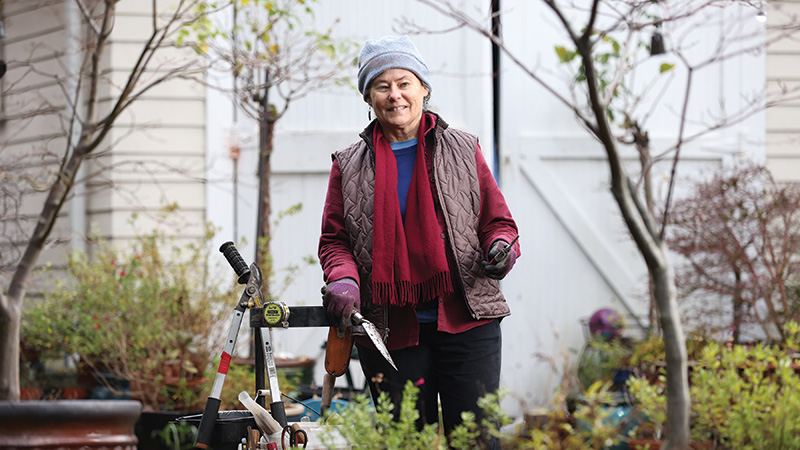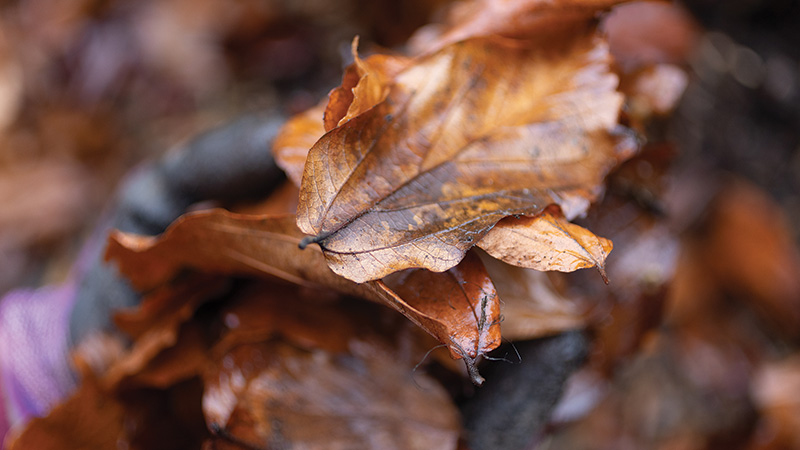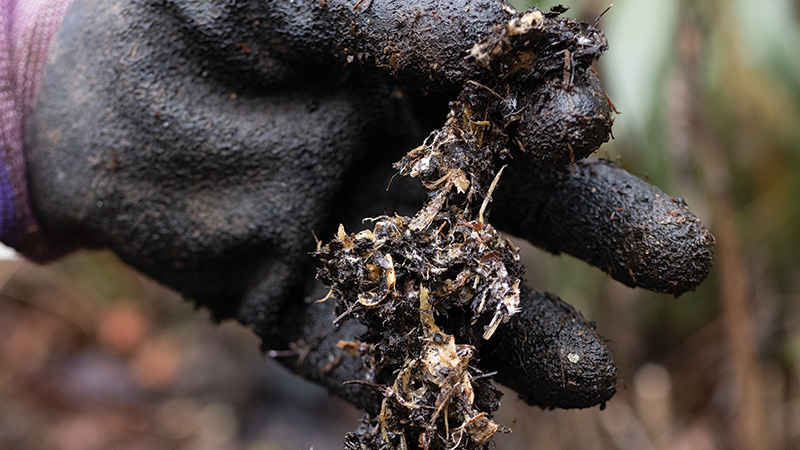Kickstarting Your Garden’s Carbon Cycle
By Georgie Smith, guest contributor
This article was originally published in March 2022

Photos by Karen Ducey.
Twenty years ago, Anne Biklé and David Montgomery planted their 2,500-square foot backyard and made the same mistake many gardeners do—they forgot to consider the soil.
With their garden in jeopardy from nutrient-poor soil the color of “beach sand,” Biklé, a Seattle-based biologist and science writer, went into panic mode. She collected spent coffee grounds from nearby coffee shops, chased arborists down city streets begging for their woodchips, and relieved a complaining neighbor of his oak leaves, all in hopes that a thick bed of mulch would protect her infant plants.
Then Biklé made what would end up being a happy mistake, becoming an accidental and influential expert in the field of regenerative gardening and health.
“I thought, I’m going to get this all spread out on the beds and then I’ll come back later, because what does every good gardener do? They dig this stuff in, right?” Biklé said. “But the fact of the matter is, between laziness and busyness, I never did go back and dig it in.”
Over the next few years Biklé, also a former environmental planner, and Montgomery, who is a geologist and University of Washington professor, watched in fascination as that undisturbed mulch layer decomposed into organic matter and their plants thrived. They had inadvertently kick-started the natural carbon cycle of their soil.
“That was when I really began to understand in a much deeper way, how organic matter is infinitely cycling through the bodies of soil life and gets transformed,” Biklé said.
This new understanding of the complex underground world that supports plant, and ultimately, human health, led the couple to co-author “The Hidden Half of Nature,” a well-received 2016 book connecting the dots between the soil microbiome and human gut health. Their second book, “What Your Food Ate: How to Heal Our Land and Reclaim Our Health,” is a deeper dive into the same topic and is slated for release in June.

Regenerative gardening
While there is no formal definition for regenerative agriculture the way there is for certified organic agriculture, it is generally considered to be a holistic set of ecosystem farming practices. Both conventional and organic farmers have found farming regeneratively improves soil health and supports crop resiliency to adverse events like drought, flooding, temperature extremes and pest and disease pressure. (For an overview click here.)
Meanwhile, soil scientists, like Ohio State University Professor Rattan Lal, the 2020 winner of the World Food Prize, tout regenerative farming for its ability to draw planet-warming carbon dioxide out of the atmosphere. Rattan’s 2004 research found that soil can sequester carbon at rates as high as 2.6 gigatons per year, about one-third of annual global emissions.
Soil-based carbon sequestration occurs when plants pull carbon out of the atmosphere through photosynthesis and then decompose, storing that carbon as soil organic carbon, according to the University of California-Davis Clarity and Leadership for Environmental Awareness and Research (CLEAR) Center.
For Biklé, the idea of locking up carbon in the soil implies a “stasis” that misses the real potential of regenerative practices—the biological cycling process between carbon, plants and the soil microbiome.
“If we can get our soils chock full of life again, that’s where it’s doing a lot of good,” Biklé said. “If we can get our soils full of life again, that life is a storage form.”
Regenerating your garden’s carbon cycle
Home gardeners may work on a smaller footprint then a regenerative farmer, but they can still reap the rewards of a robust soil microbiome and a thriving garden.
Interested in trying? Biklé has developed several strategies for regenerative gardening on a home-gardener scale, including:
Know Your Garden
Whether gardening in your backyard, a P-patch or in balcony pots, become familiar with your space. Before making changes consider “is my intervention really going to improve the situation?” Biklé said.
Plants and soil have been working in unison for over 400 million years, Biklé points out. Instead of thinking we know better—watch, observe and then figure out how to facilitate better outcomes.
Safeguard Your Soil
Consider your gardening projects from a philosophy of soil stewardship, Biklé said.
“When people start understanding and realizing that soil is a living body, like a plant or a human being, then you start to visualize the soil as this living thing. You start to think about stewardship, safeguarding and protecting your soil.”
Leaf-blowing, for example, is a common fall gardening activity, but removing that natural layer of organic matter leaves soil exposed and breaks up natural cycling processes.
Don’t Destroy, Rearrange
Reuse and rearrange organic matter to suit your gardening needs.
For instance, instead of bagging up dying plant material, Biklé moves that organic matter to garden beds where it can act as a soil-building mulch to feed and nourish her plants.
“I like to think about soil and gardening techniques that use as little as possible to get maximum benefit and effect. Organic matter and mulches, reusing that stuff and rearranging and being strategic about how you use it? I’m all for that,” she said. “It’s also saving me money.”

Don’t Dig (Tillage)
A lot of Pacific Northwest gardeners follow intensive double-digging methods to loosen up compacted soil. But digging destroys the soil structure, Biklé said. “Do I really need to dig up this entire bed down to a depth of 12 inches? Or can I, you know, kind of move and squinch things in here and there around plants?”
Before sowing spring seeds, pull back mulch and expose the soil, sow your seeds, and once they have germinated, move the mulch back. If you need to fertilize a heavy feeder like a tomato or a kale plant, instead of digging in fertilizer, layer it around the plant under a cover of mulch.
Protect Plant Roots
Every time you dig around the roots of plants, even annual vegetable or flower starts, you are destroying root systems and the mycorrhizal fungi closely associated with those roots, Biklé said.
“All you’re doing is disconnecting the plant from all of these compounds and nutrients that fungi are bringing.”
If you want to add more plants into an existing bed, plant small, young plants in 4” pots instead of plants in a half-gallon or one-gallon pot. You’re less likely to disturb existing plant roots and because the plant is smaller, it will acclimate easier to your conditions.
Provide a Diverse Diet
If you can provide animal manure—perhaps from backyard chickens or, as in Biklé’s case, worm castings—that’s great. But don’t despair if you can’t source animal manure products, she said. The real goal is diversity.
Oak leaves decompose and provide different nutrients to soil than coniferous leaves or compost made from your kitchen waste, but all are important to supporting a healthy soil microbiome.
“With mulches, I try to get as many different types of organic matter in there as I can.”
At the end of the day, always keep in mind that “regeneration” is a normal process.
“This move toward soil health is so interesting… the less we mess with the soil, the better off our gardens and farms are.”
Georgie Smith is a fourth-generation farmer on Whidbey Island. She writes about food and farming.
